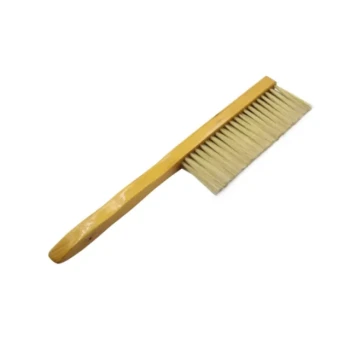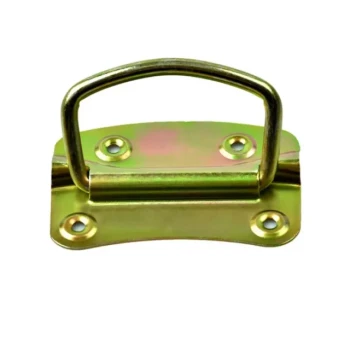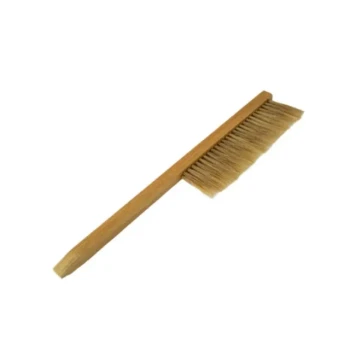At its core, a pail feeder works by using simple physics to control the flow of sugar syrup to honey bees. When the pail is filled with syrup and inverted over the hive, a vacuum is created at the top, while the surface tension of the liquid across a fine mesh screen on the lid prevents it from pouring out. Bees can then access the syrup directly through this screen as needed, making it a highly efficient feeding method.
A pail feeder is an internal hive feeder that leverages a vacuum seal and liquid surface tension. This design prevents large-scale leaks and drowning, providing bees with controlled, on-demand access to food directly inside the hive.
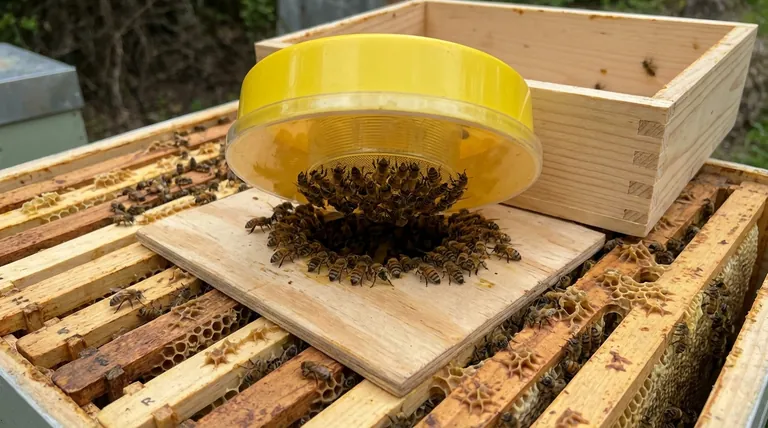
The Core Principle: Vacuum and Surface Tension
Understanding how these two forces interact is key to understanding the pail feeder's reliability. The design ingeniously balances atmospheric pressure and the properties of the syrup itself.
Creating the Vacuum
When you fill a pail with syrup and flip it upside down, the weight of the liquid tries to pull it down. This creates a pocket of low pressure, or a vacuum, in the air space at the top of the pail.
This vacuum works against the force of gravity, helping to hold the column of syrup inside the pail and preventing it from rushing out.
The Role of the Mesh Screen
The lid of the feeder has small holes covered by a fine mesh screen. This screen is the second critical component of the system.
The surface tension of the viscous sugar syrup creates a thin film across the holes of the screen. This film is strong enough to resist the pull of gravity, effectively acting as a temporary barrier that holds the liquid in place.
How Bees Access the Syrup
Bees gather on the underside of the screen and use their proboscis (tongue) to lick the syrup. As they drink, they break the surface tension on a microscopic level, drawing out a small amount of syrup.
The vacuum ensures that as syrup is consumed, only a small amount is released to replace it, preventing drips and flooding the hive. This allows the colony to regulate its own consumption efficiently.
How to Set Up a Pail Feeder
Proper setup is straightforward but essential for the feeder to function correctly and avoid leaks.
Preparation and Placement
First, fill the pail with your desired sugar water mixture, typically 1:1 syrup (one part sugar to one part water). Secure the lid tightly to ensure a good seal.
Quickly and smoothly invert the pail and place it directly over the hole in the hive's inner cover.
Enclosure and Protection
An empty hive box, often called a super or brood box, must be placed around the feeder. This creates a protected, enclosed space for the bees to access the feeder.
Finally, place the main hive cover on top of this empty box. This enclosure protects the feeder from the elements and, crucially, prevents robber bees from other colonies from accessing the food source.
Understanding the Trade-offs
Like any piece of equipment, the pail feeder has distinct advantages and disadvantages that make it suitable for specific situations.
Advantage: Reduced Robbing
Because the feeder is located inside the hive and fully enclosed, it significantly reduces the risk of robbing. Scent from the syrup is contained, preventing it from attracting bees from weaker, nearby hives.
Advantage: Minimal Drowning
Unlike open or trough-style feeders, the pail feeder's design poses almost no risk of bees drowning in the syrup. This makes it a much safer option for the colony.
Disadvantage: Hive Disturbance
The primary drawback is that you must open the hive to check the syrup level and to refill the pail. This breaks the colony's propolis seal and releases heat, which can be stressful for the bees, especially in cooler weather.
Disadvantage: Potential for Leaks
If the lid is not secured tightly or the pail is jostled, the vacuum can be broken, causing the entire contents to leak into the hive. A sudden, large leak can chill the brood and drown bees.
Is a Pail Feeder Right for Your Hive?
Choosing a feeder depends on your specific goals, the season, and your management style.
- If your primary focus is rapid feeding and preventing robbing: The pail feeder is an excellent and highly efficient choice, allowing the colony to take down syrup quickly and safely.
- If your primary focus is feeding in cool weather with minimal disturbance: You may want to consider an entrance feeder, as refilling a pail feeder requires opening the hive and releasing valuable heat.
- If you are a beginner looking for a simple, effective system: The pail feeder is a reliable and straightforward method that teaches fundamental principles of bee management.
By understanding the simple physics that make it work, you can use a pail feeder effectively to support the health and growth of your colony.
Summary Table:
| Feature | How It Works | Benefit |
|---|---|---|
| Vacuum Seal | Created when pail is inverted, holding syrup in place. | Prevents large leaks and flooding. |
| Mesh Screen | Bees break surface tension to access syrup. | Allows controlled, on-demand feeding with minimal drowning risk. |
| Internal Placement | Feeder is placed inside an empty hive box. | Significantly reduces robbing from other colonies. |
Ready to equip your apiary with reliable, efficient feeding solutions?
At HONESTBEE, we supply commercial apiaries and beekeeping equipment distributors with high-quality, wholesale pail feeders and other essential supplies. Our equipment is designed for durability and optimal hive health, helping you manage your colonies more effectively.
Contact our wholesale team today to discuss your needs and discover how our products can support your operation's success.
Visual Guide
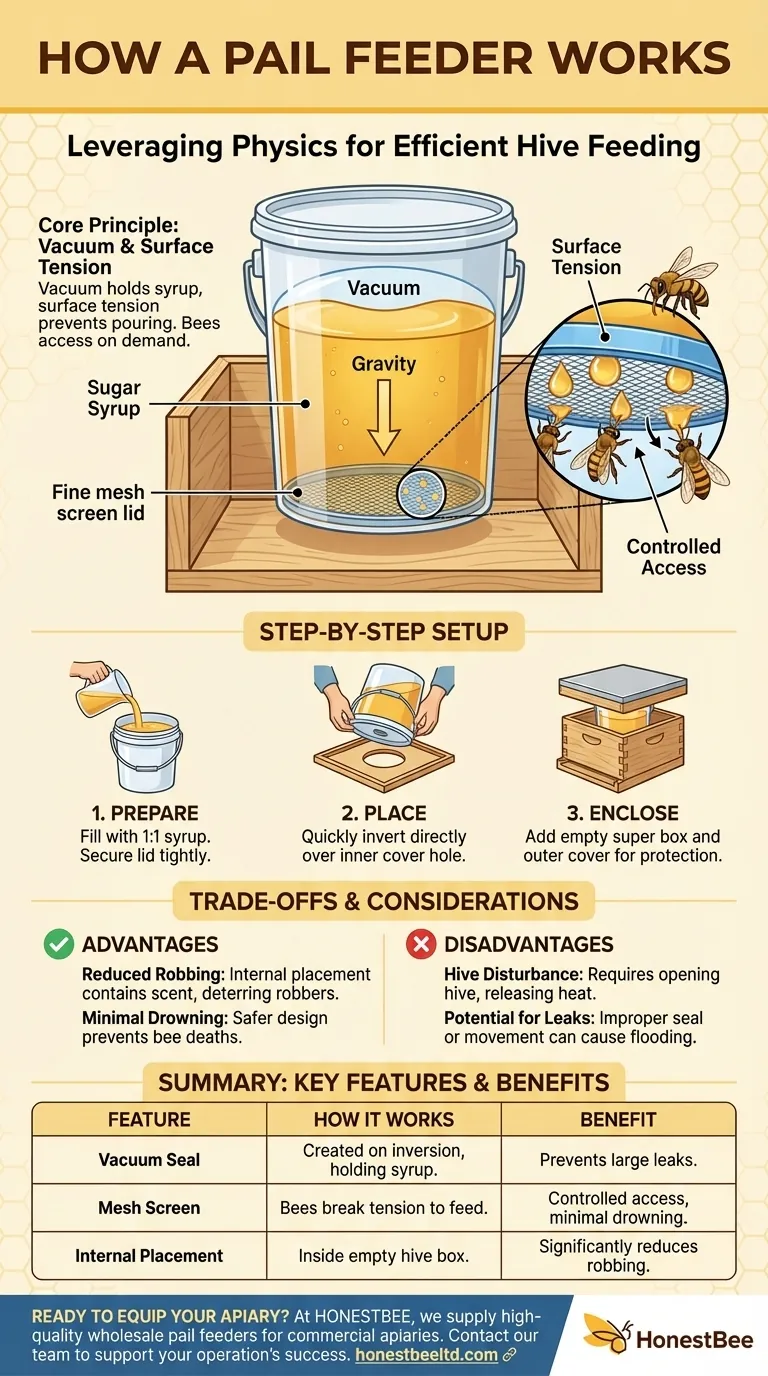
Related Products
- HONESTBEE Round Hive Top Bee Feeder for Syrup
- Rapid Bee Feeder White Plastic 2L Round Top Feeder for 8 or 10-Frame Bee Hives
- Professional Hive Top Bee Feeder for Beekeeping
- Classic Boardman Entrance Bee Feeder Hive Front Feeding Solution
- HONESTBEE Entrance Bee Feeder Professional Hive Nutrition Solution for Beekeeping
People Also Ask
- What types of hive boxes is the round hive top feeder compatible with? Universal Fit for 8 & 10-Frame Langstroth Hives
- What safety features are included in top feeders? A Guide to Drowning Prevention and Hive Safety
- What features make top feeders a reliable choice for beekeepers? A Guide to Safe, Efficient Hive Nutrition
- How should syrup for bees be prepared? Master the Ratio for a Thriving Hive
- What can the round hive top feeder be used for? A Guide to Efficient, Safe Bee Feeding














